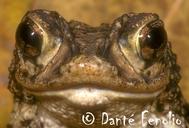|
Peltophryne lemur Cope, 1869
Puerto Rican Toad, Puerto Rican Crested Toad, sapo concho | family: Bufonidae genus: Peltophryne |
 © 2007 Danté B Fenolio (1 of 8) |
|
|
|
Description Distribution and Habitat Country distribution from AmphibiaWeb's database: Puerto Rico, Virgin Islands, British
Life History, Abundance, Activity, and Special Behaviors Trends and Threats The SSP protected a breeding site in both northern and southern Puerto Rico. The northern breeding site was not protected and no toads have been seen there since 1988. The southern site has been protected, however only about 1,000 adult toads have been observed there. Over the time that the SSP has been working with this amphibian, the population of B. lemur at the southern site has decreased to around 200 adults (Johnson 1999). Another contributor to the decline of B. lemur has been the introduction of the Giant Marine Toad (Bufo marinus), which competes for breeding sites, food, and general habitat. The purpose of the introduction (which took place in the 1920s) was to control sugar cane grubs Rats and the Indian mongoose are also believed to compete with B. lemur (Johnson 1999). Relation to Humans Possible reasons for amphibian decline General habitat alteration and loss Comments
References
Cope, E. D. (1868). ''Sixth contribution to the herpetology of tropical America.'' Proceedings of the Academy of Natural Sciences of Philadelphia, 20, 305-312. Johnson, B. (1999). ''Recovery of the Puerto Rican Crested Toad.'' Endangered Species Bulletin, XXIV, 8-9. Matos-Torres, J. J. (2006). Habitat Characterization for the Puerto Rican Crested Toad (Peltophryne [Bufo] lemur) at Guánica State Forest, Puerto Rico. M. S. thesis. University of Puerto Rico, Mayagüez Campus. Stuart, S., Hoffmann, M., Chanson, J., Cox, N., Berridge, R., Ramani, P., Young, B. (eds) (2008). Threatened Amphibians of the World. Lynx Edicions, IUCN, and Conservation International, Barcelona, Spain; Gland, Switzerland; and Arlington, Virginia, USA. Originally submitted by: Zaina Khan (first posted 2004-11-22) Edited by: Kellie Whittaker (2011-05-02) Species Account Citation: AmphibiaWeb 2011 Peltophryne lemur: Puerto Rican Toad <https://amphibiaweb.org/species/404> University of California, Berkeley, CA, USA. Accessed Jun 12, 2025.
Feedback or comments about this page.
Citation: AmphibiaWeb. 2025. <https://amphibiaweb.org> University of California, Berkeley, CA, USA. Accessed 12 Jun 2025. AmphibiaWeb's policy on data use. |




 Map of Life
Map of Life